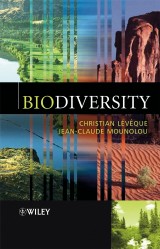Details

Biodiversity
1. Aufl.
|
63,99 € |
|
| Verlag: | Wiley |
| Format: | |
| Veröffentl.: | 21.04.2004 |
| ISBN/EAN: | 9780470091593 |
| Sprache: | englisch |
| Anzahl Seiten: | 296 |
DRM-geschütztes eBook, Sie benötigen z.B. Adobe Digital Editions und eine Adobe ID zum Lesen.
Beschreibungen
The title provides an overview of the current knowledge about the diversity of the living world and the various problems associated with its conservation and sustainable use. Covering both the fundamentals of the subject, along with the latest research, <b><i>Biodiversity</i></b> presents key conservation issues within a framework of global case studies. <p>Starting with a summary of the concept of biodiversity, the text then explores such subjects as species richness, ecological systems, the consequences of human activities, diversity and human health, genetic resources, biotechnology and conservation. </p> <ul type="disc"> <li>Comprehensive introduction to key issues surrounding the study of biodiversity.</li> <li>Extensive bibliography and references to numerous relevant websites.</li> <li>Introduces current research in the field within a framework of useful case studies.</li> </ul>
Introduction. <p><b>1 Brief history of a concept: why be concerned with biological diversity?</b></p> <p>1.1 What does ‘biodiversity refer to?</p> <p>1.2 The origins of the Convention on Biological Diversity and what is at stake.</p> <p>1.3 What is changing?</p> <p><b>2 Biological diversity: what do we know?</b></p> <p>2.1 The classification of living organisms – underlying principles.</p> <p>2.2 The inventory of species.</p> <p>2.3 Systematics, computer technology and the internet.</p> <p>2.4 measuring biological diversity.</p> <p>2.5 The geographic distribution of biological diversity.</p> <p><b>3 The mechanisms at work in the diversification of life</b>.</p> <p>3.1 What is life?</p> <p>3.2 Origins and dynamics of intra- and interspecific genetic diversity.</p> <p>3.3 How are species born?</p> <p>3.4 Extinctions.</p> <p>3.5 Adaptation: a fundamental property of living organisms.</p> <p>3.6 Major stages in the diversification of the living world.</p> <p>3.7 Is the evolution of life predetermined?</p> <p><b>4 The species richness of natural communities as a result of e quilibrium/non-equilibrium processes.</b></p> <p>4.1 Theories of equilibrium based on interspecific relationships.</p> <p>4.2 Theories of succession.</p> <p>4.3 The dynamic equilibrium of ecosystems and the role of disturbances.</p> <p>4.4 Spatial heterogeneity and temporal variability.</p> <p>4.5 Are ecological communities governed by niche-assembly or dispersal- assembly rules?</p> <p><b>5 Biological diversity and the functioning of ecological systems.</b></p> <p>5.1 Biological diversity: a dynamic system.</p> <p>5.2 The ecosystem approach.</p> <p>5.3 Functions of species within ecosystems.</p> <p>5.4 Hypotheses on the role of species in ecosystem functioning.</p> <p>5.5 Neighbourhood relationships between species.</p> <p>5.6 Food webs and trophic chains.</p> <p>5.7 The diversity of species and biological production.</p> <p>5.8 Biological diversity and the ‘stability’ of ecosystems.</p> <p>5.9 The role of biological diversity in biochemical cycles.</p> <p>5.10 The role of biological communities.</p> <p>5.11 Biological diversity and the dynamics of the biosphere</p> <p><b>6 The dynamics of biological diversity and the consequences of human activities.</b></p> <p>6.1 Paleoenvironments and biological diversity.</p> <p>6.2 Humankind and the erosion of biological diversity.</p> <p>6.3 Human activities and the dynamics of biological diversity</p> <p><b>7 The dynamics of biological diversity and implications for human health.</b></p> <p>7.1 The complexity of host–parasite relationships.</p> <p>7.2 Emerging pathologies.</p> <p>7.3 Environmental change, biological diversity and human health.</p> <p>7.4 The growing virulence of viral diseases.</p> <p>7.5 Adaptive strategies of pathogenic agents and their vectors.</p> <p>7.6 Substances of medical interest and biological diversity</p> <p><b>8 Genetic resources and biotechnology.</b></p> <p>8.1 The domestication of nature: an old story.</p> <p>8.2 Genetic diversity and domestication: creating and selecting ‘useful’ species.</p> <p>8.3 The management and diversity of genetic resources.</p> <p>8.4 The biotechnological revolution and genetically modified organisms.</p> <p>8.5 Property rights and the commercialization of living things.</p> <p>8.6 Patents on life: an open debate</p> <p><b>9 ‘Useful’ nature: the value and use of biological diversity.</b></p> <p>9.1 Benefits and services provided by ecosystems.</p> <p>9.2 Theoretical bases for assessing the economic value of biological diversity.</p> <p>9.3 Putting a price on biological diversity.</p> <p>9.4 Uses for biological diversity.</p> <p>A conclusion of sorts.</p> <p>References and further reading.</p> <p>Index.</p>
"Leveque and Mounolou provide a useful and interdisciplinary overview of the issues surrounding biodiveristy conservation and the sustainable use of biological resources…. Whether a course companion, ready reference, or guide to structuring your lecture content, this book will undoubtedly be of interest and value and deserves a place on your bookshelf." (<i>Journal of Environmental Quality</i>, July/August 2004) <p>“…very thorough, precise and up-to-date…clear, well structured and easily accessible...” (<i>Geography</i>, 2004)</p>
<p><b>Christian Lévêque</b> is the author of <i>Biodiversity</i>, published by Wiley.</p> <p><b>Jean-Claude Mounolou</b> is the author of <i>Biodiversity</i>, published by Wiley.</p>
<p>Biodiversity provides an overview of the current knowledge about the diversity of the living world and the various problems associated with its conservation and sustainable use. Covering both the fundamentals of the subject, along with the latest research, <b><i>Biodiversity</i></b> presents key conservation issues within a framework of global case studies.</p> <p>Starting with an overview of the concept of biodiversity, the text then explores such subjects as species richness, ecological systems, the consequences of human activities, diversity and human health, genetic resources, biotechnology and conservation.</p> <p>Focusing on human relationships with other species and the natural environment, <b><i>Biodiversity</i></b> is essential reading for all biologists, ecologists, geographers and environmental scientists needing a concise, up-to-date introduction to this interdisciplinary subject.</p> <ul> <li>comprehensive introduction to key issues surrounding the study of biodiversity.</li> <li>extensive bibliography and references to numerous relevant websites.</li> <li>introduces current research in the field within a framework of useful case studies.</li> </ul>

















